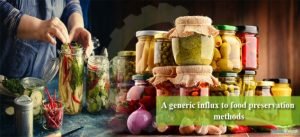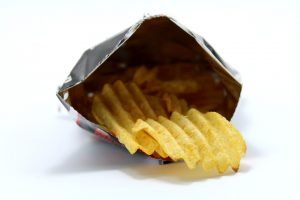Food preservation:
Food preservation is a process of handling and treating food to slowdown or stops food spoilage and extent the shelf life of food without effecting its nutritional value”. It ensures that the edibility, nutritive value and quality of the food remains intact. The preservation process involves preventing the bacterial growth, fungi and also some other microorganisms as well as stops lipid oxidation to decrease rancidity.
 Food preservation methods:
Food preservation methods:
Freezing:
It keeps prepared food stuffs in cold storage. Potatoes can be stored in dark rooms but potato preparations need to be frozen
Vacuum packing:
It creates a vacuum by making bags and bottles airtight. Since there is no oxygen in the created vacuum bacteria die. Usually used for dry fruit.
Drying:
It is the oldest method of food preservation. This method reduces water activity which prevents bacterial growth. Drying reduces weight so foods can be carried easily. Sun and wind are both used for drying as well as modern applications like Bed dryers, Liquidized bed dryers, Freeze Drying, Shelf dryers, Spray drying and Commercial food dehydrators and Household oven. Meat and fruits like apples, apricots and grapes are some examples of drying with this method.
Modified Atmosphere Packaging:
Modified Atmosphere Packaging extends the shelf life of fresh food products. The atmospheric air inside a package is substituted with a protective gas mix which ensures that the product will stay fresh for as long as possible.

Modified atmosphere:
Modified atmosphere preserves food by operating on the atmosphere around it. Salad crops that are difficult to preserve are packaged in sealed bags with an atmosphere modified to reduce the oxygen concentration and increase the carbon dioxide concentration.
Salting and Pickling:
Salting also known as curing removes moisture from foods like meat. Pickling means preserving food in brine (salt solution) or marinating in vinegar (acetic acid) and in Asia, oil is used to preserve foods. Salt kills and inhibits growth of microorganisms at 20% of concentration. There are various methods of pickling like chemical pickling and fermentation pickling. In commercial pickles sodium benzoate or EDTA is added to increase shelf life.
Potting:
Potting is a traditional British way of preserving meat by placing it in a pot and sealing it with a layer of fat.
Smoking:
It is the process that cooks, flavors and preserves food exposing it to the smoke from burning wood. Smoke is antimicrobial and antioxidant and most often meats and fish are smoked. Various methods of smoking are used like Hot smoking, Cold smoking, Smoke roasting and Smoke baking. Smoking as a preservative enhances the risk of cancer.
High pressure food preservation:
It is a method that presses foods inside a vessel by exerting 70,000 pounds per square inch or more of pressure. This disables microorganisms and prevents spoilage but food retains its appearance, texture and flavour.
Sugar:
Sugar is used in syrup form to preserve fruits or in crystallized form if the material to be preserved is cooked in the sugar till crystallization takes place like candied peel and ginger. Another use is for glazed fruit that gets superficial coating of sugar syrup. Sugar is also used with alcohol to preserve luxury foods (fruit in brandy).
Controlled use of organism:
is used on cheese, wine and beer as they are preserved for a longer time. This method uses benign organisms to preserve food by introducing them to food where they make an environment which is not suitable for harmful pathogens to grow.
Canning and bottling:
Its means sealing cooked food in sterile bottles and cans. The container is boiled and this kill or weakens bacteria. Foods are cooked for various lengths or time. Once the can or bottle is opened the food is again at risk of spoilage.
Authors: Muhammad Hassan*, Syed Shoaib Bukhari *M.Sc. (Hons.) Food Technology, University of Agriculture, Faisalabad.
